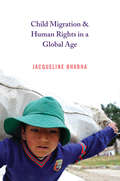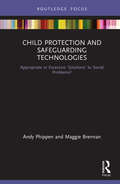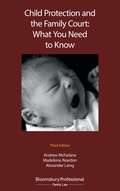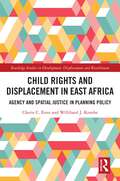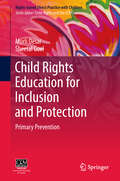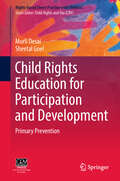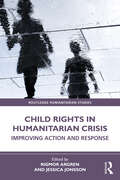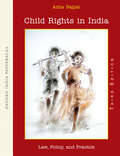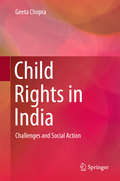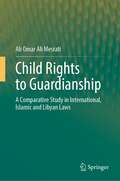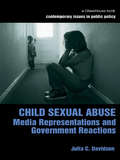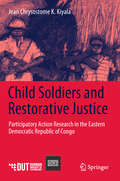- Table View
- List View
Child Migration and Human Rights in a Global Age (PDF)
by Jacqueline BhabhaWhy, despite massive public concern, is child trafficking on the rise? Why are unaccompanied migrant children living on the streets and routinely threatened with deportation to their countries of origin? Why do so many young refugees of war-ravaged and failed states end up warehoused in camps, victimized by the sex trade, or enlisted as child soldiers? This book provides the first comprehensive account of the widespread but neglected global phenomenon of child migration, exploring the complex challenges facing children and adolescents who move to join their families, those who are moved to be exploited, and those who move simply to survive.Spanning several continents and drawing on the stories of young migrants, Child Migration and Human Rights in a Global Age provides a comprehensive account of the widespread and growing but neglected global phenomenon of child migration and child trafficking. It looks at the often-insurmountable obstacles we place in the paths of adolescents fleeing war, exploitation, or destitution; the contradictory elements in our approach to international adoption; and the limited support we give to young people brutalized as child soldiers. Part history, part in-depth legal and political analysis, this powerful book challenges the prevailing wisdom that widespread protection failures are caused by our lack of awareness of the problems these children face, arguing instead that our societies have a deep-seated ambivalence to migrant children—one we need to address head-on.Child Migration and Human Rights in a Global Age offers a road map for doing just that, and makes a compelling and courageous case for an international ethics of children's human rights.
Child of Another Century: Recollections of a High Court Judge
by Ronald WaterhouseThe 20th century saw a period of enormous legal and social change in Britain. In these engaging memoirs Ronald Waterhouse, who sat as one of Britain's leading High Court Judges, provides fascinating frontline insights into the complex British legal system. Waterhouse took silk in 1969 and became a High Court judge in 1978 in the Family Division, transferring to the Queen's Bench in 1988 where he presided over well-known trials such as those of Ken Dodd and Derek Hatton. Libel, including reading libel for Private Eye with Richard Ingrams and Paul Foot, civil and personal injury work were a prominent part of his practice. After his retirement, he was appointed Chairman of the Tribunal of Inquiry into Child Abuse in North Wales Children's Homes in 1996. It was during this time that he went onto lead the biggest inquiry into child abuse ever held in Britain, publishing the highly significant and influential report 'Lost in Care' in 2000.From his early career as a barrister at Middle Temple, which saw his involvement in high-profile cases such as the notorious Moors Murders in the 1960s and Slater Walker in the 1970s, to his later work as a Judge, Waterhouse here presents a detailed and authoritative narrative of British jurisprudence in the second half of the 20th century. This unique insider's view will fascinate general readers and prove essential reading for specialists.
Child Protection and Safeguarding Technologies: Appropriate or Excessive ‘Solutions’ to Social Problems?
by Maggie Brennan Andy PhippenThis book explores, through a children’s rights-based perspective, the emergence of a safeguarding dystopia in child online protection that has emerged from a tension between an over-reliance in technical solutions and a lack of understanding around code and algorithm capabilities. The text argues that a safeguarding dystopia results in docile children, rather than safe ones, and that we should stop seeing technology as the sole solution to online safeguarding. The reader will, through reading this book, gain a deeper understanding of the current policy arena in online safeguarding, what causes children to beocme upset online, and the doomed nature of safeguarding solutions. The book also features a detailed analysis of issues surrounding content filtering, access monitoring, surveillance, image recognition, and tracking. This book is aimed at legal practitioners, law students, and those interested in child safeguarding and technology.
Child Protection and Safeguarding Technologies: Appropriate or Excessive ‘Solutions’ to Social Problems?
by Maggie Brennan Andy PhippenThis book explores, through a children’s rights-based perspective, the emergence of a safeguarding dystopia in child online protection that has emerged from a tension between an over-reliance in technical solutions and a lack of understanding around code and algorithm capabilities. The text argues that a safeguarding dystopia results in docile children, rather than safe ones, and that we should stop seeing technology as the sole solution to online safeguarding. The reader will, through reading this book, gain a deeper understanding of the current policy arena in online safeguarding, what causes children to beocme upset online, and the doomed nature of safeguarding solutions. The book also features a detailed analysis of issues surrounding content filtering, access monitoring, surveillance, image recognition, and tracking. This book is aimed at legal practitioners, law students, and those interested in child safeguarding and technology.
Child Protection and the Family Court: What you Need to Know (Bloomsbury Family Law)
by Andrew McFarlane Madeleine Reardon Alexander LaingChild protection made simple: the plain-speaking guide for all those concerned with the protection of children.Providing a clear and uncomplicated route through the child protection process. Diagrams and charts are included to aid understanding; jargon and acronyms are only included in order to explain them and key court decisions are explained in their proper context.In addition to coverage of local authority safeguarding duties and investigations, parental responsibility, wardship and the inherent jurisdiction and secure accommodation, new content in this edition includes: A chapter on special guardianship, helpful for those who find themselves involved in legal proceedings without access to legal aid, such as grandparents Developments in cases involving: Radicalisation Adoption Children or parents who are nationals of a foreign country The introduction of the Child Arrangements Programme for private law
Child Refugee Asylum as a Basic Human Right: Selected Case Law on State Resistance
by Sonja C. GroverThis book addresses the intersection of various domains of international law (refugee law, human rights law including child rights international law and humanitarian law) in terms of the implications for State obligations to child refugee asylum seekers in particular; both as collectives and as individual persons. How these State obligations have been interpreted and translated into practice in different jurisdictions is explored through selected problematic significant cases. Further, various threats to refugee children realizing their asylum rights, including refoulement of these children through State extraterritorial and pushback migration control strategies, are highlighted through selected case law. The argument is made that child refugee asylum seekers must not be considered, in theory or in practice, beyond the protection of the law if the international rule of law grounded on respect for human dignity and human rights is in fact to prevail.
Child Rights and Displacement in East Africa: Agency and Spatial Justice in Planning Policy (Routledge Studies in Development, Displacement and Resettlement)
by Cherie C. Enns Willibard J. KombeFocusing on the intersection of spatial justice, child rights, and planning policy, this book investigates the challenges of resettlement in East Africa, where half of those displaced are children. The challenges created by displacement and resettlement are often considered from an adult-centric perspective by planners and humanitarian and development experts. The spatial injustice of displacement and resettlement, the agency of children, and the application of tools such as Child Participatory Vulnerability Index (CPVI) is siloed, commonly overlooked, or discounted. This book uses a CPVI and rights-based assessment of land-use policies, to investigate resettlement due to conflict and settlement in northern Uganda, floods due to climate change in Dar es Salaam, Tanzania, and urban to rural migration of children due to the aids pandemic in Western Kenya. Case studies from over a decade of field research are integrated with examples from applied planning projects and policy development in the East Africa region. This book uses spatial justice theory to show how child-friendly planning approaches can positively promote child rights in the context of resettlement. Providing important insights on how to enact child-friendly planning in informal settlements, refugee camps, and displacement camps, this book will be of interest to planning and development professionals, and researchers across the fields of children's rights, Development Studies, Planning, and African Studies.
Child Rights and Displacement in East Africa: Agency and Spatial Justice in Planning Policy (Routledge Studies in Development, Displacement and Resettlement)
by Cherie C. Enns Willibard J. KombeFocusing on the intersection of spatial justice, child rights, and planning policy, this book investigates the challenges of resettlement in East Africa, where half of those displaced are children. The challenges created by displacement and resettlement are often considered from an adult-centric perspective by planners and humanitarian and development experts. The spatial injustice of displacement and resettlement, the agency of children, and the application of tools such as Child Participatory Vulnerability Index (CPVI) is siloed, commonly overlooked, or discounted. This book uses a CPVI and rights-based assessment of land-use policies, to investigate resettlement due to conflict and settlement in northern Uganda, floods due to climate change in Dar es Salaam, Tanzania, and urban to rural migration of children due to the aids pandemic in Western Kenya. Case studies from over a decade of field research are integrated with examples from applied planning projects and policy development in the East Africa region. This book uses spatial justice theory to show how child-friendly planning approaches can positively promote child rights in the context of resettlement. Providing important insights on how to enact child-friendly planning in informal settlements, refugee camps, and displacement camps, this book will be of interest to planning and development professionals, and researchers across the fields of children's rights, Development Studies, Planning, and African Studies.
Child Rights and International Discrimination Law: Implementing Article 2 of the United Nations Convention on the Rights of the Child (Routledge Research in International Law)
by Marit Skivenes Harald Søvig KarlSocieties and states are at a crossroad in how children are treated and how their rights are respected and protected. Children´s new position and their strong rights create tensions and challenge the traditional relationships between family and the state. The United Nations Convention on the Rights of the Child was adopted unanimously by the General Assembly of the United Nations in 1989 and came into force in 1990. Article 2 places states under an obligation to accord primacy to the best interests of the child in all actions concerning children and to ensure and regulate child protection. This book offers a comparative and critical analysis of the implementation of Article 2 of the United Nations Convention on the Rights of the Child. In order to examine how Article 2 is being implemented, it is essential to have a sound understanding of the obligations it emposes. The opening chapters will explore the precise content of these obligations in terms of the legislative history of the text, its underlying philosophy, its amplification by the United Nations Committee on the Rights of the Child, and subsequent authoritative interpretations of it by courts around the world. The book will then drill down into the conceptual and theoretical challenges posed by the very nature of the obligations and will offer in-depth exploration of the long-running ‘rights v welfare’ debate that has always presented something of a challenge in giving effect to children’s rights. Contributors are leading academics in the children’s rights field drawn from a wide range of countries and jurisdictions worldwide, including those with common law, civilian and mixed traditions. Disciplines represented in the book include law, psychology, political science, childhood studies, social work and anthropology. By drawing together the various facets of Article 2 and analysing it from a range of perspectives, the volume provides a coherent and comprehensive inter-disciplinary analysis on discrimination and the rights of the child.
Child Rights and International Discrimination Law: Implementing Article 2 of the United Nations Convention on the Rights of the Child (Routledge Research in International Law)
by Marit Skivenes Karl Harald SøvigSocieties and states are at a crossroad in how children are treated and how their rights are respected and protected. Children´s new position and their strong rights create tensions and challenge the traditional relationships between family and the state. The United Nations Convention on the Rights of the Child was adopted unanimously by the General Assembly of the United Nations in 1989 and came into force in 1990. Article 2 places states under an obligation to accord primacy to the best interests of the child in all actions concerning children and to ensure and regulate child protection. This book offers a comparative and critical analysis of the implementation of Article 2 of the United Nations Convention on the Rights of the Child. In order to examine how Article 2 is being implemented, it is essential to have a sound understanding of the obligations it emposes. The opening chapters will explore the precise content of these obligations in terms of the legislative history of the text, its underlying philosophy, its amplification by the United Nations Committee on the Rights of the Child, and subsequent authoritative interpretations of it by courts around the world. The book will then drill down into the conceptual and theoretical challenges posed by the very nature of the obligations and will offer in-depth exploration of the long-running ‘rights v welfare’ debate that has always presented something of a challenge in giving effect to children’s rights. Contributors are leading academics in the children’s rights field drawn from a wide range of countries and jurisdictions worldwide, including those with common law, civilian and mixed traditions. Disciplines represented in the book include law, psychology, political science, childhood studies, social work and anthropology. By drawing together the various facets of Article 2 and analysing it from a range of perspectives, the volume provides a coherent and comprehensive inter-disciplinary analysis on discrimination and the rights of the child.
Child Rights Education for Inclusion and Protection: Primary Prevention (Rights-based Direct Practice with Children)
by Murli Desai Sheetal GoelThe aims of child rights education are to make children and their primary duty-bearers aware of child rights so that they both can be empowered to together advocate for and apply them at their family, school and community levels. This sourcebook focuses on child rights education for primary prevention related to inclusion and protection. Child rights education for exclusion, non-discrimination and inclusion is discussed in the context of family and society with reference to girls, children with disability, and Dalit and tribal children, and child rights to cultural and financial inclusion. Child rights education for protection comprises prevention of violence against children with reference to physical abuse/ corporal punishment and bullying, commercial exploitation of children with reference to child labour and trafficking and sale of children, sexual abuse and exploitation of children, problems in adolescent sexual relationships such as violence, teenage pregnancy, abortion and unwed motherhood, and sexually transmitted infections and HIV, child marriage, and conflict with law. This is a necessary read for social workers, lawyers, researchers, trainers and teachers working on child rights across the world, and especially in developing countries.
Child Rights Education for Participation and Development: Primary Prevention (Rights-based Direct Practice with Children)
by Murli Desai Sheetal GoelThe aims of child rights education are to make children and their primary duty-bearers aware of child rights so that they both can be empowered to together advocate for and apply them at their family, school and community levels. This sourcebook focuses on child rights education for primary prevention with reference to participation and development. The introductory chapter covers child rights values of peace, dignity, tolerance, freedom, equality and justice and child rights principles of dignity of the child, primary consideration to the best interests of the child, universality and non-discrimination, and state and societal accountability. Child rights to participation focuses on child rights for playing a decisive and responsible role in their own life and a participatory role in the family, schools, associations, community and with the state as citizens. Child rights to development includes child rights to free, compulsory, comprehensive and quality education, free of discrimination and violence; child rights to play, recreational, cultural, and artistic activities and media literacy; child rights to health with reference to physical health and hygiene, healthy and hygienic food and nutrition, sexual health and prevention of substance abuse; and child rights to environmental education with reference to child rights to environmental harmony and hygiene and child rights to sustainable environment. This is a must-read for researchers, trainers, and other professionals working on child rights issues across the world, and especially in developing countries.
Child Rights in Humanitarian Crisis: Improving Action and Response (Routledge Humanitarian Studies)
by Rigmor Argren Jessica JonssonThis book demonstrates how a focus on children’s rights can help practitioners to safeguard children during humanitarian crisis. Child Rights in Humanitarian Crisis focuses on understanding and advancing child rights through practical applications of a child rights perspective in crisis response. The book establishes that with accessible, child-friendly participatory means, crisis response can improve from a child rights perspective and even advance children’s rights whilst also supporting and furthering the development of a child’s agency. The volume presents the reader with a clear focus on children from a range of backgrounds, including those most marginalised, such as children with disabilities. Drawing on expertise from the field as well as academia, and providing practical examples which link case studies to legal policies in recent and protracted humanitarian responses, such as in Turkey and at the Lithuania–Belarus border, this book is a treasure trove of advice from some of the humanitarian and development sector’s most experienced professionals. Combining insights from both research and practice, this book will be an essential read for humanitarian students and practitioners.
Child Rights in Humanitarian Crisis: Improving Action and Response (Routledge Humanitarian Studies)
This book demonstrates how a focus on children’s rights can help practitioners to safeguard children during humanitarian crisis. Child Rights in Humanitarian Crisis focuses on understanding and advancing child rights through practical applications of a child rights perspective in crisis response. The book establishes that with accessible, child-friendly participatory means, crisis response can improve from a child rights perspective and even advance children’s rights whilst also supporting and furthering the development of a child’s agency. The volume presents the reader with a clear focus on children from a range of backgrounds, including those most marginalised, such as children with disabilities. Drawing on expertise from the field as well as academia, and providing practical examples which link case studies to legal policies in recent and protracted humanitarian responses, such as in Turkey and at the Lithuania–Belarus border, this book is a treasure trove of advice from some of the humanitarian and development sector’s most experienced professionals. Combining insights from both research and practice, this book will be an essential read for humanitarian students and practitioners.
Child Rights in India: Law, Policy, and Practice
by Asha BajpaiLegislation is one of the most important tools for empowering children. It reflects the commitment of the state to promote an ideal and progressive value system. Recent years have seen several key developments in the law, policy, and practice related to child rights. Significantly, with the adoption of the United Nations Convention on the Rights of the Child in 1989, a rights-based approach has acquired prominence in the child rights discourse across the world. The book analyses the laws in the light of court judgments and policy initiatives taken in India. It also examines the interventions and strategies employed by non-governmental organizations in recommending legislative reforms in support of children. This fully revised third edition focuses on the new legal developments in India—such as the Juvenile Justice (Care and Protection of Children) Act, 2015; the new Central Adoption Resource Agency guidelines; the Right of Children to Free and Compulsory Education Act, 2009; and the National Food Security Act, 2013—thus attempting to integrate the law in theory and field practice.
Child Rights in India: Challenges and Social Action
by Geeta ChopraThe book is a comprehensive compendium on child rights in India from a child development perspective. It discusses the challenges that Indian children face for survival, development and education, especially if they are marginalized through disability, lack of care, and poverty. The major issues expounded by the author in relation to rights are infant and child survival, early child development, street and working children, children in conflict with law, children with disabilities, child trafficking and child sexual abuse. The author goes further to delve into the causes, among which are high population, poverty, migration, illiteracy, poor legislation and deep-rooted social norms and behaviour. The book presents the existing policy and legal framework in India for each of these issues. The broad purpose of the book is to comprehensively discuss the roadblocks that the marginalized child in India faces, to understand the causes of these roadblocks and to evaluate government and civil society action for children in India.
Child Rights to Guardianship: A Comparative Study in International, Islamic and Libyan Laws
by Ali Omar MesratiThis book examines how local cultures affect the interpretation of international human rights law. This book explores the Islamic legal system in its approach to the concept of guardianship and, more specifically, the approach of the Libyan legal system through a study of existing legislation and Libyan High Court (LHC) interpretation as revealed in its decisions. This book aims to show how the cultural background affects the interpretation of international human rights in domestic legal systems. This book makes a worthy contribution to promoting greater understanding of the cultural dimensions in operation in both the formulation and particularly the application of international law in Libya as elsewhere. This is an area of research which is, as a whole, one worthy of further development and examination. The book includes case analysis of important Libyan High Court rulings which have been gathered by the author and officially translated, analysed, and discussed from the three lenses namely; Libyan Law, Islamic Law, and International Law. In turn, this book is the first of its kind and unique in the field of Islamic and International Law. This book also includes detailed analysis of the correspondence between the Libyan High Court and the UN Committee on the Rights of the Child. Further, this book provides solutions and comprehensive and practical recommendations that satisfy both International standards and local Islamic and Libyan culture. This is an ever evolving and a current area of interest internationally, this unique book enriches the field and continues the conversation and provides practical sustainable solutions.
A Child Sees God: Children Talk About Bible Stories
by Howard WorsleyA Child Sees God explores how we can all learn from a child's perspective of the world and shows how a child's eye view of the Bible reveals many ideas about ethics and morality, and provides new ways of understanding these ancient stories. This fresh look at the Bible will be a fascinating read for parents, teachers, and ministers.
Child Sexual Abuse: Media Representations and Government Reactions (Contemporary Issues in Public Policy)
by Julia DavidsonChild Sexual Abuse critically evaluates the development of policy and legislative measures to control sex offenders. The last fifteen years has seen increasing concern on the part of the government, criminal justice agencies, the media and the public, regarding child sexual abuse. This concern has been prompted by a series of events including cases inviting media attention and involving the abduction, sexual abuse and murder of young children. The response to this wave of child sexual abuse revelation has been to introduce increasingly punitive legislation regarding the punishment and control of sex offenders (sex offenders are the only group of offenders in British legal history to have their own act), both in custody and in the community. But this response, it is argued here, has developed in a reactionary way to media and public anxiety regarding the punishment and control of sex offenders (who have abused children) and the perceived threat of such offenders in the community.
Child Sexual Abuse: Media Representations and Government Reactions (Contemporary Issues in Public Policy)
by Julia DavidsonChild Sexual Abuse critically evaluates the development of policy and legislative measures to control sex offenders. The last fifteen years has seen increasing concern on the part of the government, criminal justice agencies, the media and the public, regarding child sexual abuse. This concern has been prompted by a series of events including cases inviting media attention and involving the abduction, sexual abuse and murder of young children. The response to this wave of child sexual abuse revelation has been to introduce increasingly punitive legislation regarding the punishment and control of sex offenders (sex offenders are the only group of offenders in British legal history to have their own act), both in custody and in the community. But this response, it is argued here, has developed in a reactionary way to media and public anxiety regarding the punishment and control of sex offenders (who have abused children) and the perceived threat of such offenders in the community.
Child Sexual Abuse: Forensic Issues in Evidence, Impact, and Management
by Wayne Petherick India BryceChild Sexual Abuse: Forensic Issues in Evidence, Impact, and Management covers the issue of child sexual abuse from several viewpoints. The book approaches child abuse from both victimization and offender perspectives, offering applied perspectives from experts and practitioners in the field, including discussions on policing, child safety and intelligence. This is a significant divergence from the literature most commonly provided in the market. Other sections cover psychological, physical abuse, and neglect, protective factors (at individual and community levels), recognition, responses, biopsychosocial outcomes (dealt with in discrete chapters), public policy, prevention, institutional abuse, children and corrections, treatment, management, and much more.Approaches child sexual abuse from both victimization and offending perspectivesComprised of both empirical scholarship and applied material from global experts and practitionersIncludes significant advances in areas such as disclosure, the neurological effects of child abuse, neuroplasticity, trafficking, and online and virtual child abuse
Child Sexual Abuse Reported by Adult Survivors: Legal Responses in England and Wales, Ireland and Australia (Routledge SOLON Explorations in Crime and Criminal Justice Histories)
by Sinéad Ring Kate Gleeson Kim StevensonChild Sexual Abuse Reported by Adult Survivors is a wide-ranging and timely critical history and analysis of legal responses to ‘historical’ or ‘non-recent’ child sexual abuse (NRCSA) in England and Wales, Ireland and Australia, each of which represents an evolving and progressive approach to this important and complex issue. The book examines the emergence of NRCSA as a distinctive social, political and legal phenomenon in each country and explores the legal responses developed to address its unprecedented challenges. Courts and parliaments in each country have reformed existing doctrine and practice and have created new ways of holding state and private actors accountable and new ways of addressing survivors’ injuries. Criminal law, tort law, public inquiries and state reparations have all been to the forefront of these new legal responses, which have transformed law’s engagement with NRCSA survivors and understandings of justice itself. However, despite this undeniable progress, the book identifies ways in which the legal responses developed in each country fail to deliver accountability and recognition to NRCSA survivors and argues that such failures betray the law’s inherent ambivalence to delivering justice for these survivors. Creating new insights into legal responses to this complex contemporary legal, social and political problem, this book will be of great interest to academic lawyers, political scientists and historians, as well as those working on related topics in criminology, sociology, social policy, cultural studies and gender studies.
Child Sexual Abuse Reported by Adult Survivors: Legal Responses in England and Wales, Ireland and Australia (Routledge SOLON Explorations in Crime and Criminal Justice Histories)
by Sinéad Ring Kate Gleeson Kim StevensonChild Sexual Abuse Reported by Adult Survivors is a wide-ranging and timely critical history and analysis of legal responses to ‘historical’ or ‘non-recent’ child sexual abuse (NRCSA) in England and Wales, Ireland and Australia, each of which represents an evolving and progressive approach to this important and complex issue. The book examines the emergence of NRCSA as a distinctive social, political and legal phenomenon in each country and explores the legal responses developed to address its unprecedented challenges. Courts and parliaments in each country have reformed existing doctrine and practice and have created new ways of holding state and private actors accountable and new ways of addressing survivors’ injuries. Criminal law, tort law, public inquiries and state reparations have all been to the forefront of these new legal responses, which have transformed law’s engagement with NRCSA survivors and understandings of justice itself. However, despite this undeniable progress, the book identifies ways in which the legal responses developed in each country fail to deliver accountability and recognition to NRCSA survivors and argues that such failures betray the law’s inherent ambivalence to delivering justice for these survivors. Creating new insights into legal responses to this complex contemporary legal, social and political problem, this book will be of great interest to academic lawyers, political scientists and historians, as well as those working on related topics in criminology, sociology, social policy, cultural studies and gender studies.
Child Soldier Victims of Genocidal Forcible Transfer: Exonerating Child Soldiers Charged With Grave Conflict-related International Crimes
by Sonja C. GroverThis book provides an original legal analysis of child soldiers recruited into armed groups or forces committing mass atrocities and/or genocide as the victims of the genocidal forcible transfer of children. Legal argument is made regarding the lack of criminal culpability of such child soldier 'recruits' for conflict-related international crimes and the inapplicability of currently recommended judicial and non-judicial accountability mechanisms in such cases. The book challenges various anthropological accounts of child soldiers' alleged 'tactical agency' to resist committing atrocity as members of armed groups or forces committing mass atrocity and/or genocide. Also provided are original interpretations of relevant international law including an interpretation of the Rome Statute age-based exclusion from prosecution of persons who were under 18 at the time of perpetrating the crime as substantive law setting an international standard for the humane treatment of child soldiers.
Child Soldiers and Restorative Justice: Participatory Action Research in the Eastern Democratic Republic of Congo
by Jean Chrysostome KiyalaThis book investigates how, while children used as soldiers are primarily perceived as victims of offences against international law, they also commit war atrocities. In the aftermath of armed conflict, the mainstream justice system targets warlords internationally, armed groups and militias’ commanders who abduct and enrol children as combatants, leaving child perpetrators not being held accountable for their alleged gross human rights violations. Attempts to prosecute child soldiers through the mainstream justice system have resulted in child rights abuses. Where no accountability measures have been taken, demobilised young soldiers have experienced rejection, and eventually, some have returned to soldiering. This research provides evidence of the potential of restorative justice peacemaking circles and locally-based jurisprudence – specifically the Baraza - to hold former child soldiers accountable and facilitate their reintegration into society.
